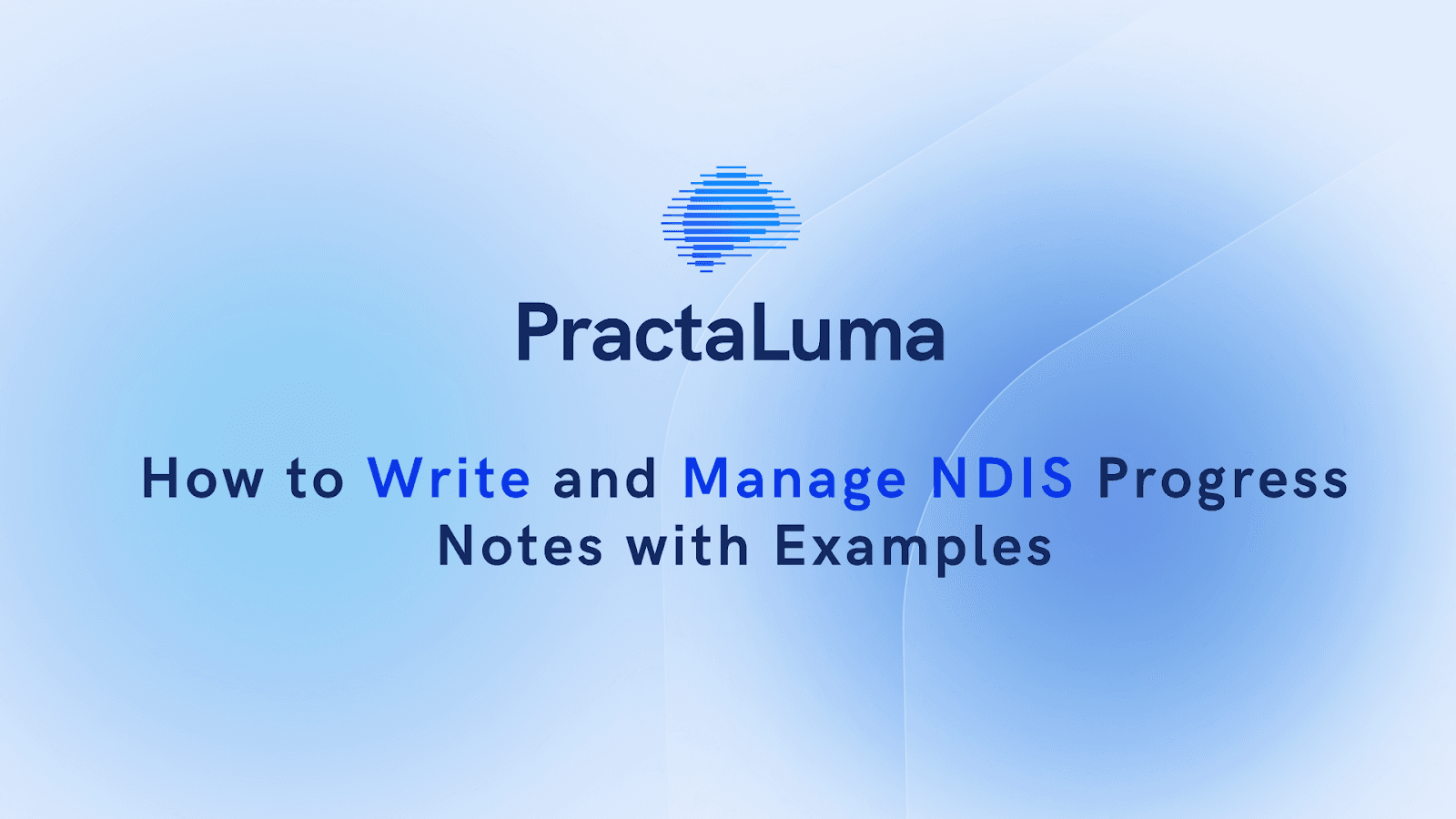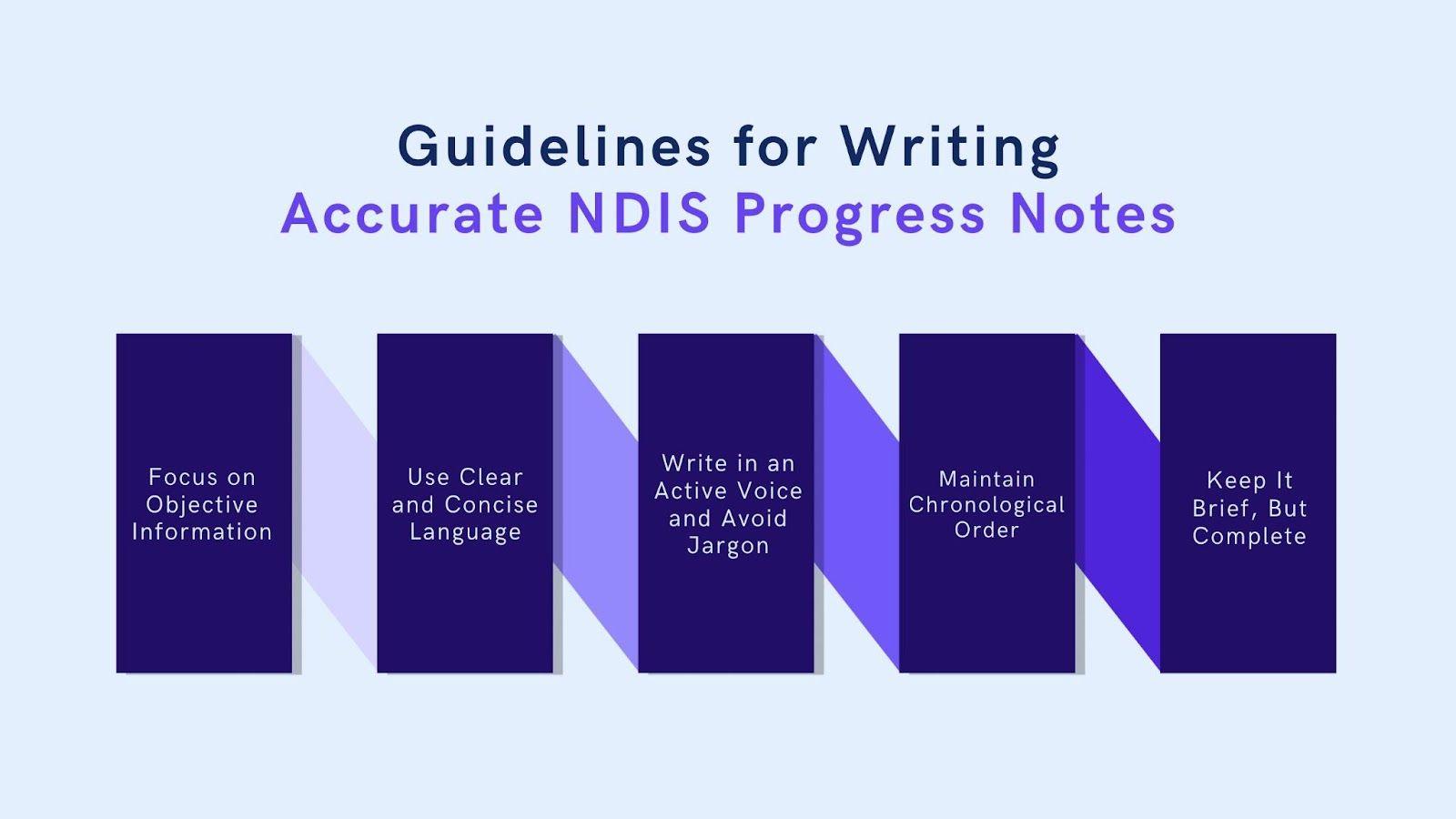
5 May 2025
How to Write and Manage NDIS Progress Notes with Examples
In the world of disability support, accurate and comprehensive progress notes are more than a legal obligation—they’re a lifeline for ensuring the delivery of quality care under the National Disability Insurance Scheme (NDIS).
Progress notes document a patient’s journey and provide vital insights for tailoring support plans and ensuring accountability. This blog will guide you through writing and managing NDIS progress notes. With practical examples and actionable tips, you’ll learn how to create transparent, compliant, and impactful notes, empowering you to deliver the highest support standard to NDIS participants.
Understanding NDIS Progress Notes
NDIS progress notes are systematic records created by caregivers, support workers, and health professionals under the National Disability Insurance Scheme (NDIS). These notes document services provided, participant responses, and outcomes achieved in alignment with individualised care plans. Rooted in evidence-based practice, progress notes serve as both a clinical tool and a compliance measure, ensuring accurate tracking of interventions and their effectiveness over time.
Acts as a Tool for CollaborationNDIS Progress notes are indispensable for maintaining continuity and communication for caregivers and healthcare professionals. They provide a shared reference point, ensuring all stakeholders—care teams, families, and participants—are aligned on goals and strategies. Accurate documentation supports audit readiness and legal compliance, protecting providers and building participant trust.
With the purpose and significance of NDIS progress notes clearly outlined, let’s explore the essential components that make these records practical and actionable.
Why Do NDIS Progress Notes Matter?
NDIS progress notes are a pillar of effective care delivery under the National Disability Insurance Scheme. Their importance extends beyond simple documentation as a critical tool for tracking progress, ensuring compliance, and facilitating collaboration.
1. Tracking Participant Progress
Progress notes provide a detailed record of a participant’s journey. Documenting services provided, outcomes achieved, and intervention responses clearly show how well care plans work.
2. Evaluating Interventions
NDIS progress notes allow caregivers and health professionals to measure the success of interventions in real-time. They help identify what’s working, what needs adjustment, and how to improve outcomes.
3. Compliance and Accountability
Under the NDIS, maintaining thorough progress notes is a legal requirement. These notes ensure service providers comply with regulatory standards and protect them during audits or reviews. Accurate documentation fosters transparency, builds participant trust, and safeguards against potential disputes.
4. Collaboration Across Teams
Progress notes act as a central communication tool in a multidisciplinary care setting. They ensure that all stakeholders—care teams, families, and participants—are aligned on goals, strategies, and outcomes.
Example:
A patient named Emily, a 27-year-old participant in the NDIS program, experiences mobility challenges due to a recent spinal cord injury.When Emily began physiotherapy, she struggled to balance on parallel bars. Progress notes from her therapist recorded her initial difficulties, including frequent stumbling and reliance on assistance. For three weeks, the notes documented her gradual improvement, including a milestone where Emily managed to walk unaided for 3 meters with a walker.
Results:
Based on this progress, her therapist updated her care plan to introduce advanced exercises, such as navigating slight inclines and practising longer distances. These notes provided valuable insights during team reviews, ensuring Emily’s goals were aligned with her improving abilities.
Considering these real-world applications, let’s explore the key components that make NDIS progress notes effective and impactful.
Key Components of Effective NDIS Progress Notes
Writing practical NDIS progress notes requires attention to detail and a clear structure. Each note should contain essential information that ensures accuracy, supports compliance, and enhances care delivery.
1. Essential Information
Every progress note must include the following details to maintain clarity and accountability:
- Writer’s Name: Identifies who recorded the note.
- Date and Time: Establishes when the service was delivered.
- Service Context: Briefly describe the type of support given (e.g., therapy session, daily living assistance).
2. Specific Details of Services and Outcomes
Include precise information about what was done during the session and the resulting participant's progress. This helps in assessing the effectiveness of services and aids in goal tracking:
- Service Provided: Outline activities or interventions performed.
- Outcomes Achieved: Document any observable progress or challenges during the session.
- Relevance to Goals: Link services to the participant’s broader care objectives.
3. Record of Significant Incidents and Factual Observations
Document noteworthy events or behavioural patterns to ensure comprehensive care records:
- Notable Changes: Highlight any significant behavioural or emotional shifts.
- Incident Details: Include specifics of events such as refusal to engage, safety concerns, or milestone achievements.
- Factual Observations: Avoid assumptions; record only what is observed or reported.
Now that we have a solid understanding of these components, let’s examine the guidelines for writing accurate and professional progress notes.
Guidelines for Writing Accurate NDIS Progress Notes

Accurate and professional NDIS progress notes ensure clarity, compliance, and effectiveness. Following these guidelines can help you create notes that are both actionable and easy to understand.
1. Focus on Objective Information
Rather than assumptions or opinions, write your notes based on facts and observable behaviours. Stick to what you see, hear, or know based on the interaction.
Example: Write “The participant walked 10 meters unassisted” instead of “The participant seemed to improve in mobility.”
2. Use Clear and Concise Language
Avoid lengthy or complex sentences. Progress notes should be easily read and quickly understood by anyone reviewing them.
- Tip: Keep sentences between 15–25 words.
- Example: “Assisted with meal preparation. The participant successfully chopped vegetables with minimal guidance.”
3. Write in an Active Voice and Avoid Jargon
Active voice makes your writing direct and engaging while avoiding jargon and ensures notes are accessible to all stakeholders.
- Example (Active Voice): “Completed a cognitive exercise with the participant.”
- Avoid: “The participant completed the exercise.”
- Replace jargon like “psychomotor skills” with simpler terms like “movement coordination.”
4. Maintain Chronological Order
Record events in the order they occur during the session to ensure the note flows logically and accurately reflect the participant’s experience.
Example: Start with the intervention, describe the participant’s reaction, and end with outcomes.
5. Keep It Brief, But Complete
While brevity is essential, ensure all key details are included. A concise but thorough note is both professional and efficient.
Pro Tip: Focus on the session's “what,” “why,” and “how” without overloading with unnecessary information.
With these guidelines in place, let’s explore some well-documented examples of NDIS progress notes.
Examples of Well-Documented NDIS Progress Notes
Here are examples of well-documented progress notes that follow the principles of clarity, conciseness, and professionalism:
Example 1: Daily Living Support
- Date and Time: 18 December 2024, 9:30 AM
- Writer: Sarah White, Support Worker
- Note:
- Assisted with morning routine, including meal preparation and grooming.
- The participant brushed their teeth independently and prepared a simple breakfast with minimal guidance.
- Observed increased confidence during the tasks, stating, “I feel like I’m getting better at this.”
- Suggested practising similar routines daily to build consistency and confidence.
Example 2: Mobility Training
- Date and Time: 20 December 2024, 2:00 PM
- Writer: John Martin, Physiotherapist
- Note:
- Conducted a 30-minute mobility session focused on balance exercises.
- The participant completed walking 10 meters unassisted and demonstrated improved posture.
- They expressed slight fatigue but showed a willingness to attempt more advanced exercises.
- Plan: Introduce strength-building exercises in the next session.
Example 3: Social Engagement Activity
- Date and Time: 22 December 2024, 3:15 PM
- Writer: Lisa Brown, Support Worker
- Note:
- Supported the participant during a community social event.
- Observed initial hesitation, with the participant remaining quiet and avoiding interaction.
- After encouragement, the participant conversed with one group member for five minutes.
- Highlighted progress: “I enjoyed talking to them, but it was hard at first.”
- Plan: Incorporate role-playing activities to build confidence in initiating social interactions.
Example 4: Incident Reporting
- Date and Time: 23 December 2024, 4:00 PM
- Writer: Emily Grant, Caregiver
- Note:
- Participant refused to engage in scheduled exercise activities, stating, “I’m not feeling up to it today.”
- Observed signs of agitation, including pacing and raised voice.
- I provided emotional support and rescheduled the activity for a later time.
- Plan: Review triggers with the participant to identify potential stressors before activities.
Now that we’ve explored a few examples, let’s discuss how to organise and store NDIS progress notes securely and efficiently.
Organising and Storing NDIS Progress Notes

Efficient organisation and secure storage of NDIS progress notes are essential for maintaining confidentiality, ensuring compliance, and enabling easy access when required. Here’s how to effectively manage these records.
1. Secure Storage Practices
Confidentiality is a legal and ethical obligation. Progress notes must be stored securely to protect participant information from unauthorised access.
- Use locked cabinets for physical records.
- For digital records, implement password-protected systems and encrypted storage solutions.
- Regularly audit storage methods to ensure compliance with NDIS guidelines.
2. Utilising Electronic Systems
Digital systems simplify the organisation, retrieval, and backup of progress notes. They also reduce the risk of misplacing or damaging records.
- Electronic health record (EHR) systems are designed for disability care.
- Categorise notes by date, participant name, and type of service for quick access.
- Schedule regular backups to prevent data loss due to technical failures.
3. Access Restrictions and Review Management
Control access to progress notes to safeguard participant privacy while ensuring necessary availability for authorised personnel.
- Restrict access based on role and responsibility, allowing only caregivers and supervisors to view specific notes.
- Set up a system for management reviews to ensure the accuracy and quality of documentation.
- Maintaining an access log to track who views or edits records ensures accountability.
Conclusion
NDIS progress notes are vital to delivering high-quality support under the National Disability Insurance Scheme. They provide a clear and structured way to document services, track participant progress, and evaluate the effectiveness of interventions. Accurate and well-maintained notes foster better communication among caregivers, ensure compliance with legal and ethical standards, and ultimately improve participant outcomes.
Managing NDIS progress notes can be time-consuming and complex, but it doesn’t have to be. At Practaluma, we specialise in providing tools and solutions to make your documentation process seamless, accurate, and efficient. Our tailored services are designed to help caregivers, support workers, and healthcare providers confidently meet NDIS requirements.
Why Choose Practaluma?
- Customised Templates: Access professionally designed templates that align with NDIS standards, saving time and ensuring comprehensive records.
- Training and Workshops: Learn best practices for writing transparent and compliant progress notes through our expert-led training programs.
- Digital Documentation Solutions: Streamline your processes with user-friendly electronic systems that improve organisation and enhance accessibility.
- Regulatory Compliance Support: We will ensure that your progress notes meet all legal and ethical guidelines, reducing the risk of audit issues or penalties.
- 24/7 Support: Whether you have questions or need troubleshooting help, our team can assist you whenever needed.
Transform Your Documentation Process Today
Partner with Practaluma to simplify your NDIS progress note management and focus on what matters most—delivering exceptional care to participants.
Ready to get started?Contact us today to schedule a consultation or explore our range of services. Let us help you create a seamless, professional documentation process that empowers your team and enhances participant outcomes.